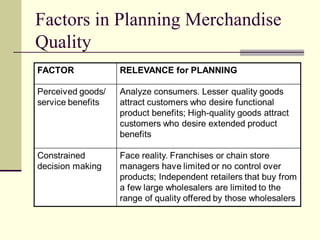Developing merchandising plan
- 1. Developing Merchandise Plans Dr. Gopal Thapa Tribhuvan University
- 2. Merchandising Activities involved in acquiring particular goods and/or services and making them available at the places, times, and prices and in the quantity that enable a retailer to reach its goals
- 3. Merchandising Philosophy Sets the guiding principles for all the merchandise decisions that a retailer makes Should reflect ▪ Target market desires ▪ Retailer’s institutional type ▪ Market-place positioning ▪ Defined value chain ▪ Supplier capabilities ▪ Costs ▪ Competitors ▪ Product trends
- 4. Scope of Merchandising Responsibility Full array of merchandising functions Buying and selling Selection, pricing, display, customer transactions OR Focus on buying function only
- 5. Micro-merchandising Retailer adjusts shelf-space allocations to respond to customer and other differences among local markets
- 6. Cross-Merchandising Retailers carry complementary goods and services to encourage shoppers to buy more
- 7. Attributes and Functions of Buying Organizations
- 8. Functions Performed Merchandising view All buying and selling functions Assortments Advertising pricing Point-of-sale displays Employee utilization Personal selling approaches
- 9. Functions Performed (cont.) Buying view Buyers manage buying functions Buying Advertising Pricing In-store personnel manage other tasks Assortments Point-of-sale displays Employee utilization Personal selling approaches
- 10. Merchandising Versus Store Management Career Tracks
- 12. Forecasts These are projections of expected retail sales for given periods Components: Overall company projections Product category projections Item-by-item projections Store-by-store projections (if a chain)
- 13. Types of Merchandise Staple merchandise Assortment merchandise Fashion merchandise Seasonal merchandise Fad merchandise
- 14. Staple Merchandise Regular products carried by a retailer Grocery store examples: milk, bread, canned soup Basic stock lists specify inventory level, color, brand, style, category, size, package, etc.
- 15. Assortment Merchandise Apparel, furniture, auto, and other categories for which the retailer must carry a variety of products in order to give customers a proper selection Decisions on Assortment Product lines, styles, designs, and colors are projected Model stock plan
- 16. Fashion and Seasonal Merchandise Fashion Merchandise: Products that may have cyclical sales due to changing tastes and life-styles Seasonal Merchandise: Products that sell well over nonconsecutive time periods
- 17. Factors in Planning Merchandise Innovativeness
- 18. Factors in Planning Merchandise Innovativeness
- 19. Factors in Planning Merchandise Innovativeness
- 20. Structured Guidelines for Pruning Products Select items for possible elimination on the basis of declining sales, prices, and profits, appearance of substitutes Gather and analyze detailed financial and other data about these items Consider nondeletion strategies such as cutting costs, revising promotion efforts, adjusting prices, and cooperating with other retailers After making a deletion decision, do not overlook timing, parts and servicing, inventory, and holdover demand
- 21. Factors in Planning Merchandise Quality
- 22. Factors in Planning Merchandise Quality
- 23. Factors in Planning Merchandise Quality
- 24. Retail Assortment Strategies Width of assortment refers to the number of distinct goods/service categories (product lines) a retailer carries Depth of assortment refers to the variety in any one goods/service category (product line) a retailer carries An assortment can range from wide and deep (department store) to narrow and shallow (box store
- 25. Brands Manufacturer (national) Private (dealer or store) Generic
- 26. Timing The retailer must decide: ▪ When they are first purchased, displayed and sold ▪ Peak season, order and delivery time ▪ Routine vs special order, stock turnover, discount and efficiency of inventory turnover
- 27. Allocation How much merchandise to place on the sale floor How much to place in a stockroom and whether to use a warehouse A chain also apportions products among stores
- 28. Category Management Category management is a retailing and purchasing concept in which the range of products purchased by a business organization or sold by a retailer is broken down into discrete groups of similar or related products; these groups are known as product categories
- 29. Category Management Merchandising techniques that some firms including several supermarkets, drugstores, hardware stores, and general merchandise retailors, - use to improve productivity It is a way to manage retail business that focuses, on the performance of product category results rather than individual brands





























